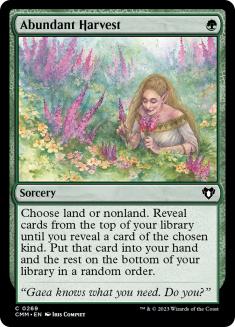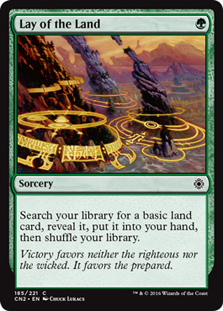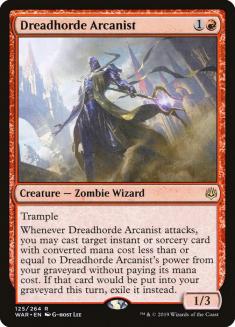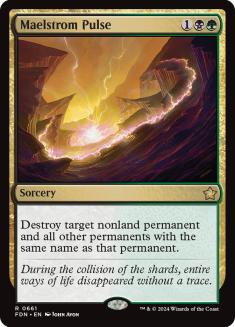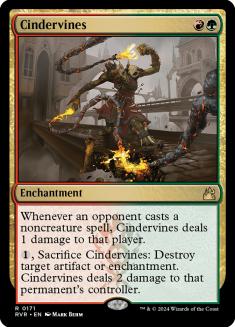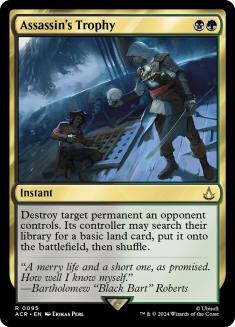Last week I discussed some underplayed options to play in Historic, particularly in response to the incredibly powerful Mizzix’s Mastery from Strixhaven’s Mystical Archive.
Five-Color Emergent Ultimatum can be a bit of a head-scratcher. Oddly, from the perspective of its opponent, you don’t really need to know that much about the intricacies of the deck. Learning how to play a strategy is often the best way to prepare against it, but ultimately you want to just avoid your opponent from resolving Emergent Ultimatum — whether through Mizzix’s Mastery or Scholar of the Lost Trove.
All that said, Gerry’s piece on the deck is still excellent, and gleaning some knowledge about how the deck might sideboard against your strategy is invaluable, so I’d still give him a click and you’ll learn something.
Although Five-Color Emergent Ultimatum has defined the battleground of Historic, the format is still relatively wide open as the influx of power and content has made the format difficult to begin solving again, with the clear front-runner pre-Strixhaven, Jund Sacrifice, not picking up nearly the level of power as the rest of the format.
My level-up moment this week was gaining a real appreciation for Abundant Harvest, another card that I’ve never played with, and how much influence it can have on deckbuilding.
Abundant Harvest looks fairly inconspicuous on first read — it can only be a cantrip, and although you do have agency over what type of card you draw, you don’t have the ability to work your way through “bad spells” like a scry or an Opt can. Just like Brainstorm (and we’ll cover how strong this pair is shortly), Abundant Harvest is a bit more of a thinker in terms of cantrips.
What are the implications of the green sorcery?
1. Abundant Harvest lets you play more games with low-land decks where you won’t flood or screw.
This might sound simple on the surface, but compare Abundant Harvest to a Lay of the Land variant. Having the aforementioned basic land tutor is excellent in your opening hand and will typically mean that you’ll get to develop over the first few turns and play Magic, but if your opening hand is a copy of the spell and five lands, it’s functionally a mulligan. Abundant Harvest doesn’t exactly fix that type of hand, but it does broaden the range of keepable hands that your deck can have.
Furthermore, it’s a low-opportunity-cost cycling card later in the game when you don’t want to draw any more lands, while the Lay of the Land is functionally a brick of a draw step.
Where you really start to see the power of Abundant Harvest is with tight tempo decks that want to play ~21 lands. These types of decks (spoiler alert, Phoenix and Arcanist strategies) absolutely must draw their second land but aren’t necessarily in a hurry to hit their fourth, and certainly aren’t interested in playing a sixth. A degree of “inconsistency” can often plague these strategies if they don’t have enough agency over manipulating the cards that they draw.
Further, these types of decks often use other types of cantrips instead of playing higher land counts to help enable that level of agency to the player depending on the situation. It’s likely that you can Opt twice into a land over two turns – but it isn’t guaranteed, and when you miss once in five games or so, it is often a death knell.
Compare that single land opening comparison of two Opts to two Abundant Harvests. You know you’re going to hit your second land drop on time, and you even have multiple draw steps to determine whether you need to seek out your third, or you can transfer the second copy into a nonland spell. The level of reliability is incredible.
2. Abundant Harvest pairs extremely well with Brainstorm.
Simply, Abundant Harvest is the “shuffle” effect that we’ve been looking for to maximize Brainstorm.
Of course, Fabled Passage is the lay-up card to pair with Brainstorm, but even that is a bit awkward early in the game and Historic has only picked up speed and explosiveness. Beyond that, we mostly had to get creative — Opting cards to the bottom, using Narset to Impulse cards away, or simply taking it on the chin and having Brainstorm be a “normal” cantrip.
The amount of end-step Brainstorms I’ve played against on Turn 1 is embarrassing, but decks just aren’t built very well to use it right now.
Abundant Harvest is going to change that, and it’s pretty simple. There’s now a large range of ways for you to filter through your draws with the combination of Brainstorm and Abundant Harvest. And most critically of all it’s only a two-mana setup. The piles are straightforward, so I won’t spell it out blatantly, but you can either churn through lands or spells depending on what the situation calls for, or even “shuffle” only one card away if necessary.
Together, this pair now offers a viable route for Historic control decks to start to move down from the gargantuan land counts that they needed previously. I don’t know exactly how low we can go — I’m down to 26 or so when previously 28 was the norm — but figuring out this deckbuilding puzzle will be critical for the slower strategies to compete in the long term.
3. Abundant Harvest gives nonblue decks legitimate card selection.
Dreadhorde Arcanist plus Abundant Harvest is a game-changer.
The slow but consistent movement from Arcanist variants being an A+B strategy — almost a synergistic combo deck in the way it utilized Claim the Firstborn and Village Rites alongside Stitcher Supplier — to a deck that simply plays strong cards really cements it as a top contender in an Eternal format.
It’s hard to wrap one’s head around the fringe possibilities here too. Does Goblins get stronger by playing Abundant Harvest? It isn’t clear to me, but I wouldn’t be surprised if someone put in the work and was heavily rewarded.
Putting it all into practice, I just mentioned Jund Arcanist, so let’s start there.
Creatures (12)
Lands (22)
Spells (26)

I’m a broken record about Dreadhorde Arcanist decks, but I’m very happy with this list.
Like I alluded to previously, its card quality is much higher and there’s largely no risk anymore of having dysfunctional draws where you draw the A side of your deck but no B. Kroxa, Titan of Death’s Hunger is a bit weaker than it was previously when everything was humming with Stitcher’s Supplier and Village Rites, but Faithless Looting still does a good job of enabling the powerful Titan and the games in which you flood are cut by orders of magnitude.
Further, the green splash just does a lot to fix the deck’s weaknesses. Previously I was begrudging playing Abrades or Bedevils in the maindeck to hedge against Grafdigger’s Cage and planeswalkers, but Maelstrom Pulse just covers it all (including Rest in Peace or whatever anyone might throw at you).
The sideboard reinforces that with Cindervines and Assassin’s Trophy as flexible answer cards that don’t feel like such a crapshoot with the question of “Will this line up with my opponent’s draw?” Faithless Looting mitigates this problem further. We also get to play Scavenging Ooze, a great addition to any Lurrus strategy and an excellent card in the format right now, as I mentioned last week.
Let’s check in on the other lean strategy — one that I’ve mocked previously — Temur Phoenix.
Creatures (14)
Lands (21)
Spells (25)

Sorry Ross, I couldn’t resist playing Dreadhorde Arcanist.
It probably looks weird to be splashing a color for a single maindeck card, but I do feel that strongly that Abundant Harvest fixes a lot of the problems with Izzet Phoenix traditionally — the land conundrum that I spoke about earlier, but also it’s a cantrip that will frequently hit another spell on the critical Phoenix-enabling turns.
I certainly understand the hesitation about Dreadhorde Arcanist here. It’s another card that feels the effects of hate, and it can’t contribute to returning Phoenix, but its ability to snowball the game for you so rapidly when your deck isn’t in full-blown combo mode is unparalleled, and forces your opponent to respond quickly or get buried.
I’m not confident in my sideboard here at all, but it feels foolish to not try to maximize the options of a third color. We can pick up a wide range of anti-aggressive cards, and although I think Lovestruck Beast and Weather the Storm are the best options for combating red-based strategies, the format is, to reiterate, still highly in flux.
I’m a huge fan of Ross’s addition of Test of Talents to his sideboard though. It makes a lot of sense and we’ll be seeing it in the following decks as well, serving as an effective tool against Five-Color Emergent Ultimatum.
Creatures (4)
Planeswalkers (7)
Lands (26)
Spells (23)

I don’t think I’ve butchered Ondrej’s deck.
It feels really weird to only be playing three copies of Nissa, Who Shakes the World, but given the fact that our card selection is so much stronger and our deck as a whole has gotten leaner, I believe it to be correct.
A big lesson to learn from having more card selection in your deck is that the value of every slot in your deck, especially niche cards with Brainstorm, is amplified. Aether Gust certainly has less of a chance to be a dead card, and it can be shuffled away now, but perhaps Bant Control is more in the market for some spicy singletons or one more extremely high-impact card.
As it stands, I built the deck to reflect the decline in creature strategies and to be committed to executing its relatively linear gameplan of assembling some planeswalkers and getting over the finish line. Yasharn simply might not be necessary to play anymore, given the state of the metagame, but I do like that it’s an excellent bridge card and another shuffle effect for Brainstorm. Another huge appeal of this deck is how strong Narset, Parter of Veils is right now and will continue to be as Historic is supporting these lower-to-the-ground cantrip decks.
Again, I wouldn’t be shocked if I was still overestimating the amount of lands this deck needs to play to function. And at that point perhaps it can get even more interactive and completely eschew meatier top-end like Hydroid Krasis.
Finally, as usual I saved the most fun for last:
Creatures (2)
Planeswalkers (3)
Lands (26)
Spells (29)

While not the most interactive, Temur Magma Opus can play a combo-control strategy quite well. It’s consistent and can quickly start firing off whatever the plural of Opus is [Copy Editor’s Note: “Opera” or “Opuses.”] as well as doing completely nonsensical things with Mizzix’s Mastery (I never expected to overload this card as much as I have).
Oracle of Mul Daya is just the most fun possible with Brainstorm and taking extra turns, and you even get some bonus shenanigan interactions with Prismari Command turning into Mind Rot and then some with Narset, Parter of Veils. I don’t know if this deck is necessarily stronger than Bant Control since it has fewer defensive measures, but it’s undeniably a blast and has a lot of potential for refinement.
Hopefully your takeaway from today is pretty simple — put more Abundant Harvests in your Historic decks. I’m confident that it’s the catalyst for changing how we build decks in the format.


